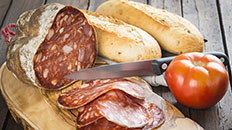Meats and Sausages
Morcón Andaluz
A typical Andalusian morcón that can be found in the province of Huelva and other areas. Morcón is a type of short (8”, 20 cm) chorizo like sausage which stuffed into pig blind cap (caecum also known as cecum), an intestine called in Spanish “morcón”, thus its name. The large diameter dry sausage is very popular in the regions of Andalusia and Extremadura and in the province of Salamanca in Castilla-León. Morcón sausage has dark red color and deep flavor and aroma. Best morcón is produced from Iberian pigs that feed on oak acorns.
| Meats | Metric | US |
|---|---|---|
| Iberian pig pork butt (shoulder), neck meat or both | 1000 g | 2.20 lb |
Ingredients per 1000g (1 kg) of meat
| Salt | 28 g | 4.5 tsp |
| Cure #2 | 2.5 g | 1/2 tsp |
| Pimentón, sweet | 25 g | 4 Tbsp |
| Pimentón, hot | 6.0 g | 1 Tbsp |
| Garlic | 12 g | 4 cloves |
| White wine | 60 ml | 2 oz fl |
Instructions
- Manually cut pork meat with fat attached into 20-30 mm (3/4-1.5") cubes.
- Mix all ingredients with meat together. Hold for 24 hours in refrigerator.
- Stuff firmly into pork cap (caecum) large intestine, around 18-25 cm (8-10”) long. Reinforce lengthwise and across with twine.
- Dry at 12-15° C (53-59° F), 75-80% humidity for 2-3 months. The total time depends on the diameter of the sausage and temperature/humidity. In natural chambers without control of temperature and humidity the drying time could be from 3-4 months or even longer.*
- Store at 12° C (53° F), 65% humidity.
Notes
* It is hard to maintain steady temperature and humidity in natural chambers. Finished product exhibits strong red color and is about 12-15 cm (5-6") thick, and 25-30 cm (12-14") long. Net weight around 1 kg (2.2 lb).
In traditional production the temperature was maintained by burning oak wood when necessary. Cure #2 was not added either.
Store in a cool, dry and lightly ventilated dark place.
Consume raw.
In traditional production the temperature was maintained by burning oak wood when necessary. Cure #2 was not added either.
Store in a cool, dry and lightly ventilated dark place.
Consume raw.


















